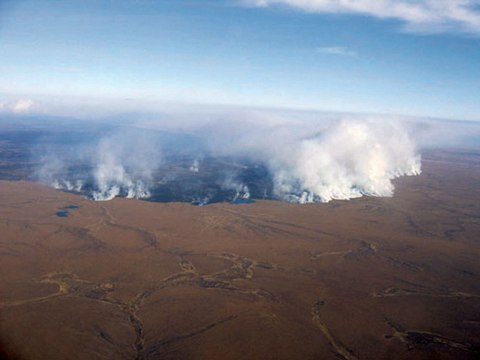While we’re on the subject of methane and feedback loops, the fires are growing more destructive in the boreal regions of the North, in fact worse than at any time in the last 10,000 years. These fires decrease the region’s albedo effect by blackening the Earth’s surface and they peel away the insulating layer of lichen and moss on the forest floor, exposing the underlying permafrost to accelerated thawing and microbial decomposition of the soils. These infernos result in an immediate release of methane and CO2 from the fires themselves and later from the freshly exposed permafrost below.
Chris Mooney in Mother Jones:
Scientists have known for some time about the risk of large-scale carbon emissions from thawing permafrost. But in recent years, they’ve become increasingly attuned to an additional—and very worrisome—aspect of this threat. As climate change proceeds, larger and more intense wildfires are increasingly scorching and charring the forests of the north. While these fires have always been a natural and recurring aspect of forest ecosystems, they now appear to be undergoing a major amplification. And that, in turn, may further increase the threat of permafrost thawing and carbon releases—releases that would, in turn, greatly amplify global warming itself (and potentially spur still more fire activity).
“You have this climate and fire interaction, and all of a sudden permafrost can thaw really rapidly,” explains Jon O’Donnell, an ecologist with the National Parks Service’s Arctic Network. Scientists call it a “positive feedback,” and it’s one of the…
View original post 306 more words


The really really bad news is that none of the climate models incorporate positive feedback loops. Doing so would of course drive the model into rapid and unstable results. Sort of like what is really happening. The climate models are in fact far too conservative.
LikeLike
Add this to the dozen or so positive feedback loops we already have and pretty soon things start to look downright bleak!
LikeLike
Study: Boreal forests burning at historic rate
Published 10:06 am, Monday, July 29,
FAIRBANKS, Alaska (AP) — The world’s boreal forests, which stretch from interior Alaska to the Atlantic Ocean and span regions of Russia and Scandinavia, are burning at a rate considered historically unprecedented, according to a new study of the Yukon Flats region.
Researchers concluded fire rates would likely continue to grow in the future, the Fairbanks Daily News-Miner (http://is.gd/3jF140) reported.
The study was published last week in the Proceedings of the National Academy of the Sciences.
Both fire frequency and the amount of biomass burned are higher now than they’ve been in the past 10,000 years, according to researchers. And the length of the fire season and the intensity of the fires have increased in just the past decade, said state forester Chris Maisch, director of the Alaska Division of Forestry.
“We’re observing change,” Maisch said. “There’s no doubt about it.”
http://www.sfgate.com/news/science/article/Study-Boreal-forests-burning-at-historic-rate-4693529.php
LikeLike
“By 2100 most of the forests of the world should be heavily, heavily disturbed, if not gone.”
LikeLike
Enjoy them while they are here, I suppose.
LikeLike
There’s very little actual “forest” left unless you include what are obviously timber farms with no biodiversity. A few boutique spots for eco-commerce. Over-all a pretty pathetic remnant of what life was like even during my life time.
LikeLike
Certainly true. Forests are pretty much timber warehouses at this point.
LikeLike
In other words…. WAF
LikeLike